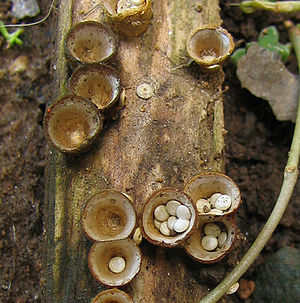
The Peridium is a term used to describe the protective layer that encloses a mass of spores.[1][2]
In the simplest subterranean forms, the peridium, remains perfectly closed until the spores are mature, and even then shows no special arrangement for dehiscence or opening, but has to decay before the spores are liberated. [3]
For most fungi, the peridium is ornamented with scales or spines. In species that become raised above ground during their development, generally known as the "puffball", the peridium is usually differentiated into two or more layers, where the outer layer is usually resolved into warts or spines. In contrast, the inner layer remaining continuous. Somtimes, as in the case of Geaster, the number of layers is greater and the exoperidium eventually splits from the apex into a variable number of pointed portions; however, the inner remains intact by a definite aperture at the apex. In contrast, the inner layer, also known as the endoperidium, is a smooth inner layer. [4] In contrast, earthball fungi generally have only one peridium.[5]
Usage edit
The peridium is often termed a specific name for different species of fungi. For example, the peridium of the sub-family Phalloideae is called volva. In addition, the peridium can refer to the outer "nest" of a bird's-nest fungi.[6]
References edit
- ^ http://ilmyco.gen.chicago.il.us/Terms/gleba304.html
- ^ British Fungus- Flora, by George Massee; page 6; Published by George Bell and Sons, 1892
- ^ ' Fungi Mycetozoa and Bacteria.' Eng. Ed. ' A Monograph of the British Gastromycetes,' 'Annals of Botany,' vol. iv. 1889.
- ^ British Fungus- Flora: A Classified Textbook of Mycology; By George Massee; Published by George Bell and Sons, 1892; Item notes: v.1; Original from Harvard University; Digitized Jun 1, 2007
- ^ The Genera of Fungi; By Frederic Edward Clements; Published by The H. W. Wilson company, 1909; Original from the University of Michigan; page 195
- ^ http://www.mushroomthejournal.com/greatlakesdata/Terms/birds233.html